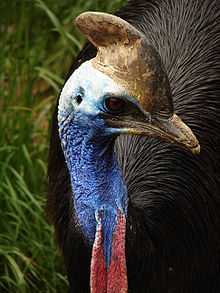Casuariiformes
| Casuariiformes Temporal range: Pliocene–present Pliocene to present | |
|---|---|
 | |
| Southern Cassowary. | |
| Scientific classification | |
| Kingdom: | Animalia |
| Phylum: | Chordata |
| Class: | Aves |
| Order: | Casuariiformes Sclater 1880[1] Sclater 1880[1] |
| Family | |
|
Casuariidae | |
| Diversity | |
| 2 Family, 3 Genera (including 1 extinct), 10 Species (including 6 extinct) | |
The bird order Casuariformes has four surviving members: the three species of cassowary, and the only remaining species of Emu. The emus are classified in the family, Dromaiidae, while the Cassowaries are all located within the Casuariidae family.
All four members of the order are very large flightless birds native to Australia-New Guinea.[2] The characteristics of the family are those of its members.
Systematics and evolution

The emus form a distinct family, characterized by legs adapted for running. As with all ratites, there are several contested theories concerning their evolution and relationships. As regards this order, it is especially interesting whether emus or cassowaries are the more primitive form: the latter are generally assumed to retain more plesiomorphic features, but this does not need to be true at all; the fossil record is also ambiguous, and the present state of genomics does not allow for sufficiently comprehensive analyses. A combination of all these approaches with considerations of plate tectonics at least is necessary for resolving this issue.
The number of cassowary species described based on minor differences in casque shape and color variations is quite large[citation needed]. In recent times, however, only 3 species are recognized, and most authorities only acknowledge few subspecies or none at all.
The fossil record of casuariforms is interesting, but not very extensive. Regarding fossil species of Dromaius and Casuarius, see their genus pages.
Some Australian fossils initially believed to be from emus were recognized to represent a distinct genus, Emuarius,[3] which had a cassowary-like skull and femur and an emu-like lower leg and foot. In addition, the first fossils of mihirungs were initially believed to be from giant emus,[4] but these birds were completely unrelated.
Footnotes
- ↑ 1.0 1.1 Brand, S. (2008)
- ↑ Clements, J (2007)
- ↑ From "Emu" + "Casuarius". Describer W. E. Boles commonly refers to the genus as "emuwaries" or "cassomus".
- ↑ The vernacular name "mihirung" is derived from mihirung paringmal, which means "giant emu" in the Chaap Wuurong language
References
- Boles, Walter E. (2001). "A new emu (Dromaiinae) from the Late Oligocene Etadunna Formation". Emu 101: 317–321. doi:10.1071/MU00052.
- Brands, Sheila (Apr 8, 2012). "Taxon: Order Casuariiformes". Project: The Taxonomicon. Retrieved Jun 17, 2012.
- Clements, James (2007). The Clements Checklist of the Birds of the World (6 ed.). Ithaca, NY: Cornell University Press. ISBN 978-0-8014-4501-9.
- Folch, A. (1992). "Family Casuariidae (Cassowaries)". In del Hoyo, J., Elliott, A. & Sargatal, J. Handbook of the Birds of the World. 1 Ostrich to Ducks. Lynx Edicions. pp. 90–97. ISBN 84-87334-09-1.
External links
| Wikimedia Commons has media related to Casuariidae. |
| ||||||||||||||||||||||||||